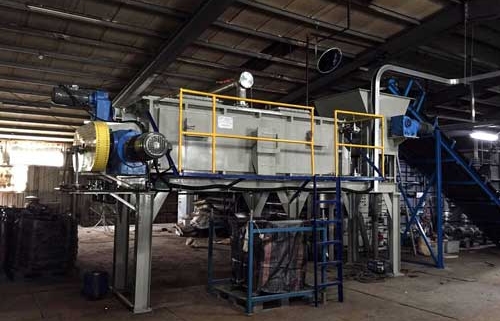Drying equipment is a kind of mechanical equipment that uses heat to reduce the moisture of materials and is used to dry objects. The drying apparatus vaporizes moisture in the material (generally referred to as moisture or other volatile liquid component) by heating to obtain a solid material having a specified moisture content.
The purpose of drying is for the purpose of material use or further processing. For example, the drying of the wood before the production of the wood mold and the wood can prevent the deformation of the product, and the drying of the ceramic material before the calcination can prevent the product from cracking. In addition, the dried material is also convenient for transportation and storage, such as drying the harvested food to a certain moisture content to prevent mildew. Since natural drying is far from meeting the needs of production development, various mechanized drying equipments are becoming more and more widely used.
Drying equipment features
Characteristics of drying equipment Most dryers are non-standard equipment, mainly because the materials processed by each dryer are different. Many drying conditions change with materials, which leads to changes in the structure and materials of the dryer. .
Therefore, it is necessary to clarify the specific parameters of the material to be dried, such as the state of the material, the type of moisture contained, the amount of treatment, the characteristics of the material during the drying process, whether it is corrosive, burning and explosive, whether static electricity is generated, the specific requirements of the product, and the heat sensitivity of the material. The temperature, etc., can determine the various parameters of the dryer. For this reason, many dryers cannot be mass-produced, and attention must be paid to the material’s pertinence and adaptability to working conditions during the design process.
Classification of drying equipment
Types of drying equipment So far, there have been hundreds of drying equipments that have been successfully developed, and there are more than one hundred kinds of drying equipment commonly used in industrial production. There are various classification methods for drying equipment. If the heat transfer method according to the drying process can be divided into convection dryers (such as air flow dryers, spray drying equipment, rotary quick dryers, fluidized bed dryers, etc.), conduction heat transfer. Dryers (such as sputum dryers, roller dryers), radiation dryers (such as microwave dryers, far infrared dryers), etc. In addition, there are drying equipment such as paddle dryers that combine several heat transfer methods.
There are many types of drying equipment. According to the operating pressure, it can be divided into normal pressure and decompression (decompression drying equipment is also called drying equipment). According to the operation method, it can be divided into batch type and continuous type. According to the drying medium, it can be divided into air, flue gas or other drying medium. According to the movement (material movement and drying medium flow), it can be divided into cocurrent, countercurrent and crossflow.
Press operating pressure
According to the operating pressure, the drying equipment is divided into two types: atmospheric drying equipment and vacuum drying equipment. Under vacuum operation, the wet partial steam partial pressure can be reduced to accelerate the drying process, and the wet boiling point and material drying temperature can be lowered. Leakage, therefore, the vacuum dryer is suitable for drying heat sensitive, oxidizable, explosive and toxic materials and wet steam needs to be recycled.
By heating
According to the heating method, the drying equipment is divided into a convection type, a conduction type, a radiation type, a dielectric type and the like. Convection drying equipment, also known as direct drying equipment, uses a hot drying medium to directly contact wet materials to transfer heat in a convective manner and to carry the generated steam away; a conductive dryer, also known as an indirect dryer, utilizes conduction. The heat is transferred from the heat source to the wet material through the metal partition wall, and the generated wet steam can be removed by vacuum suction, a small amount of purge gas or condensation on the surface of the separately disposed low temperature condenser. This type of drying equipment does not use drying medium, has high thermal efficiency, and the product is not polluted, but the drying capacity is limited by the heat transfer area of the metal wall, the structure is also complicated, and it is often operated under vacuum; the radiant drying equipment utilizes various radiations. The electromagnetic wave emitted by a certain wavelength range is selectively absorbed by the surface of the wet material and then converted into heat for drying; the dielectric drying device utilizes a high-frequency electric field to cause a thermal effect inside the wet material to be dried.
According to the way the wet material moves
According to the movement mode of wet materials, the drying equipment can be divided into fixed bed type, agitated type, spray type and combined type; according to the structure, the drying equipment can be divided into box drying equipment, conveyor type drying equipment, drum type drying equipment, and Drying equipment, mechanical agitating drying equipment, rotary drying equipment, fluidized bed drying equipment, airflow drying equipment, vibrating drying equipment, spray drying equipment, and combined drying equipment.
The drying process of the drying equipment requires a large amount of heat energy. In order to save energy, some materials with high moisture content, suspensions or solutions containing solid substances are generally mechanically dehydrated or heated and evaporated, and then dried in a dryer to obtain a dry solid.
In the drying process, the drying equipment needs to complete the transfer of heat and mass (moisture) at the same time, ensuring that the moisture partial pressure (concentration) of the surface of the material is higher than the partial pressure of moisture in the external space, and the temperature of the heat source is higher than the temperature of the material.
Heat is transferred from the high temperature heat source to the wet material in various ways, so that the surface of the material is vaporized and escaped to the external space, so that the difference in moisture content occurs on the surface and inside of the material. The internal moisture partition diffuses and vaporizes to the surface, so that the moisture content of the material is continuously reduced, and the overall drying of the material is gradually completed.
The rate of drying of the material depends on the rate of surface vaporization and the rate of diffusion of the internal moisture. Usually, the drying rate in the early stage of drying is controlled by the surface vaporization rate; then, as long as the external conditions of drying are constant, the drying rate and surface temperature of the material remain stable. This stage is called the constant-speed drying stage; when the moisture content of the material is reduced to a certain To the extent that the rate of diffusion of the internal moisture to the surface decreases and is less than the surface vaporization rate, the drying rate is mainly determined by the internal diffusion rate and decreases with the decrease of the moisture content. This stage is called the slow-down drying stage.
Drying equipment requirements for materials
The materials processed by the drying equipment are difficult to count. In addition to the physical and chemical properties of various materials and the requirements of the products, the thermophysical properties of the materials in the drying process and the material requirements for the drying system equipment during the heating process are more important issues for designers. Some methods are proposed for the use of drying equipment for designers’ reference.
Preface Drying equipment is one of the most widely used unit equipment. It can be considered that the application of drying equipment has spread throughout the various departments of national production. For drying equipment, it must not be simply considered to be a thermophysical dewatering machine. Due to the different materials processed during the drying process and the different types of wet materials, the various indicators of the products are also different. The installation location of the equipment is different. There are different requirements for the selection of the drying equipment, the type of equipment, and the manufacturing and installation methods. Proper handling of these issues is one of the important factors in the successful design of drying equipment.



